Charlie Chaplin’s Modern Times: Dynamics of the situation based on organisations as machines: An assay
Modern Times is a 1936 comedy film written and directed by Charlie Chaplin. Chaplin’s character is seen as a worker being driven crazy by his boring, inhuman work on a conveyor belt and being used as an experimental host to test a machine to feed workers as they work. Funny clip, though a great example of organizations as machines. According to Morgan, organisations are machines in which people are parts; employees are expected to operate like clockwork by working to certain processes, take the rest according to certain guidelines and repeat that in a mechanical way (Morgan, 2006).
Machine organisations are started from the military services, from which it borrowed ranks, uniforms, standardised regulations, and task specialisation. It produces routine administration in the same way as machines in factories (Morgan, 2006). Movie starts with a clock approaching to 6.00; all the employees walking through the road to reach the factory on time, which is the classical example of any organization where employees are expected to arrive at work on given time.
As movie proceeds, machine lever is pulled up and work started in the automated factory of the Electro Steel Corporation as per the routine protocol. Similarly, other part of the factory, president was served a glass of water in much mechanized way before he was supposed to make an observation of the work at the factory. In machine organizations, commands should give from the top and reach throughout the organization in a precisely distinct way to have accurately defined results.
It was seen that president was instructing an employee (could be a manager) signifies unity of command which according to classical management theory, an employee should receive orders from superior. Usually it is seen that mechanistic organizations culture focused on rules and standards, where operational processes are rigidly controlled with best-practices methodologies and close supervision. Charlie tries to smoke in the bathroom but the manager found him there by means of a surveillance camera, and when he rudely orders him back to work. According to Prof. Morin, work can serve as a tonic for personal identity in that it helps boost self-esteem (Morin, 2004).
When an individual does a meaningful work, he progresses toward sense of identity, worth, and dignity (Morin, 2004). By achieving meaningful results, he actually achieves himself, grows, and even, actualizes his full potential. In the later part, different portions of the factory were obvious where diverse type of works was in progress, and group of people engaged with precisely defined work; which shows the division of labour at work. Overall, a good organizational structure was seen in the factory which was workers, shift supervisor, manager and president. At the moment, machines influenced virtually every aspect of our life. Furthermore, with the invention and proliferation of machines, the concepts of organization became more mechanized. While working on the assembly line, Charlie is driven crazy by the pace of the machine and the tough manner of his co-workers.
The manager, sitting at his desk, orders a speed-up the belt; the workers have doubled their effort. The separation of the people making the decisions and those carrying them out is wide. The employees are just told what to do and their input is not asked for or wanted. Charlie gets a signal that makes him move like a machine. Stuck on a conveyer belt, he runs through the machine and becomes part of it. However, mechanistic organisations work fine if the task is simple, repetitive and high precision is required in the work in a stable environment conditions.
For example, software industry or fast food industry such as McDonald, Burger King may benefit from these highly controlled structures. However, in the other side, machine organisations discourage creativity and innovation throughout the organization and nurtures bureaucracy. Front-line employees will be less satisfied from their jobs as evident in the clip. Additionally, the industry which is associated with creativity, imagination may find difficulties while working in mechanistic organizations.
References
- Morgan G. (2006). Mechanization takes command: organization as machines. In: Morgan G. (ed) Images of Organization. Thousand Oaks,
- California: Sage Publications, 11-31. Morin, E. M. (2004). The meaning of work in modern times. 10th World Congress on Human Resources
- Management, Rio de Janeiro, Brazil. August, 20th, 2004. Available at: http://web.hec.ca/criteos/fichiers/upload/MOW_in_MTimes_EMM200804.pdf (Accessed on 06/10/2013)





